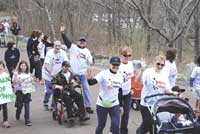Rite of Spring – As You Get Back in Shape, Listen to Your Body
Q: Now that the warmer weather has arrived, and along with it a return to outdoor sports, how can I get back into shape so I don’t hurt myself? The same goes for my kids, who are active in school sports.
A: Getting yourself back in shape to play sports isn’t something that happens overnight. Pushing the body too far can cause physical injury, especially for those lacing up their running shoes. We call this the terrible toos — too much, too fast, too soon. It takes at least two weeks to get into even minimal shape for participating in any recreational sport. Listen to your body and watch for any pain or discomfort you may be having, as well as feeling fatigued. It’s your body saying it has had enough.
Also, consider — whether for yourself or your child athlete — especially if any of you have been inactive for a while, to first get a general physical exam to make sure the body is in good shape to begin playing sports.
Q: What about pre-conditioning?
A: To play it safe before beginning any sport — whether spring, summer, fall or winter — you should consider some pre-conditioning such as aerobic exercise, walking, cycling, or jogging for 30 minutes, at least four times a week. It’s also important to include a minimum of 15 to 20 minutes of weight training twice a week to get into shape.
Q: I want to begin running daily. What injuries should I be aware of?
A: Runners often suffer from muscular strains and tendinitis. To help prevent these injuries, you should take it slow, especially if you are beginning a new regimen or are a first-time runner. You will also need to change your footwear every six months.
Q: What types of injuries should I be aware of for my kids, who are very active in school sports?
A: As the spring and summer months give way to more team sports — from soccer to baseball to volleyball and a host of others, including field hockey, tennis, and more — it’s important to remember that most injuries, some 62{06cf2b9696b159f874511d23dbc893eb1ac83014175ed30550cfff22781411e5} of them, occur during practices, not games. The most common types of sport-related injuries in children are sprains (mostly ankle), muscle strains, bone or growth plate injuries, tendinitis, and contusions, although more serious injuries, such as fractures and ligament or tendon tears, may also occur.
A growing concern is the increasing number of concussions — some 3.8 million youngsters suffer from sports and other recreational concussions each year, which, untreated or recurring, can lead to neurological disorders such as dementia and Parkinson’s disease. Of special note, never allow a child to play through any injury. All coaches should have a plan for dealing with emergencies.
Here are some additional things to keep in mind for both you and your children:
- Always wear appropriate protective gear for the activity — for practice as well as games — and make sure it’s the right size and properly adjusted;
- Make sure responsible adults know and enforce the safety rules of the sport, are present to provide supervision, and are trained in first aid and CPR;
- If you’re playing outside, wear SPF 15 or higher sunscreen;
- Follow the rules. In most sports, the rules are based not only on sportsmanship, but safety; and
- Stay hydrated. Drink plenty of water or electrolyte sports drinks before and during the activity, and take breaks frequently during hot weather.



Comments are closed.